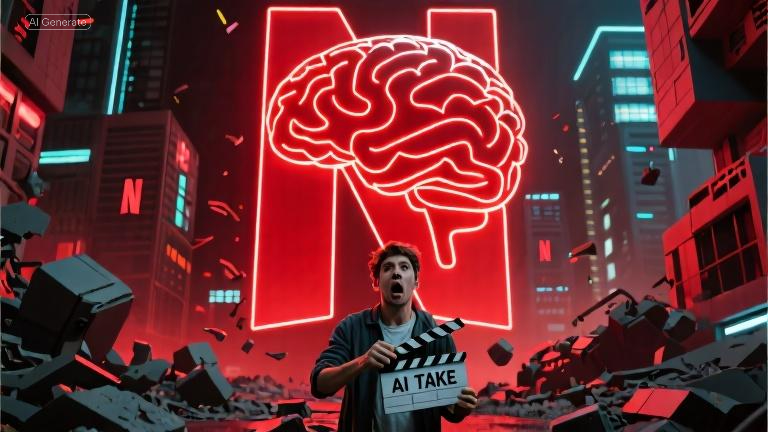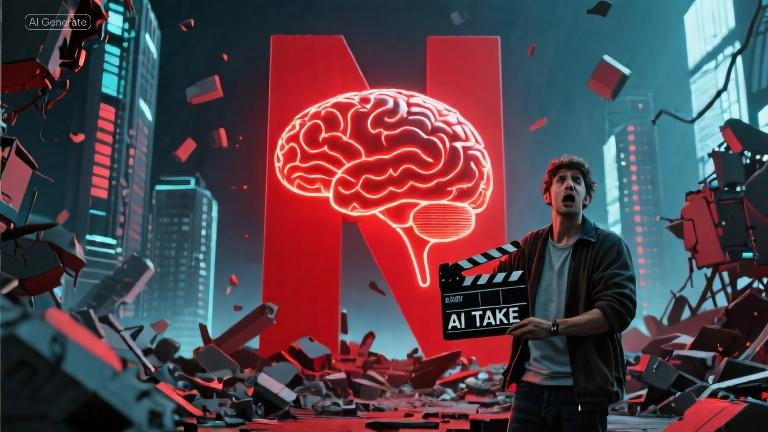Netflix just made a move that could reshape production economics across the entertainment industry. For the first time ever, they’ve admitted to using AI for final footage that viewers actually watched on their platform. This wasn’t just background elements or minor effects—we’re talking about a dramatic building collapse scene in their Argentine series ‘El Éter’ that was created entirely through artificial intelligence. What makes this even more remarkable? The scene was produced about ten times faster and cheaper compared to traditional visual effects. This admission might seem small, but it represents a fundamental shift that could transform how every movie and show gets made. The question is: how did they pull this off without anyone noticing?

The Scene That Changed Everything
Picture millions of Netflix viewers watching a building dramatically collapse in slow motion, debris cascading through the air with photorealistic precision. Nobody questioned what they saw. Nobody suspected anything unusual. The scene felt completely authentic, matching the production quality viewers expect from Netflix content. But here’s what makes this moment extraordinary: every pixel of that destruction was generated by artificial intelligence. The building never actually collapsed. No physical models were destroyed. No traditional visual effects teams spent months crafting the sequence frame by frame.
What does this mean for entertainment production? Well, traditionally, creating a building collapse scene for a series like ‘El Éter’ would have been financially impossible. A single complex destruction sequence typically requires specialized VFX studios, teams of digital artists, and months of rendering time that can easily consume enormous portions of a regional production’s budget. Most productions simply write around these limitations, cutting ambitious sequences or settling for off-screen explosions.
Netflix’s AI approach flipped this entire model. The building collapse was generated using advanced machine learning algorithms trained on massive datasets of real destruction footage, architectural physics, and environmental interactions. What enabled this leap? Simple text prompts and machine-learning models trained on real disaster footage—but with creative direction from the team. The AI systems analyzed how concrete fractures, how debris behaves in different lighting conditions, and how dust particles interact with camera movement. The result was footage that captured the chaotic unpredictability of real destruction while maintaining complete digital control over every element.
Here’s why this technical achievement matters so much: the entire sequence was completed in days rather than months, at roughly one-tenth the traditional cost. But Netflix was taking an enormous risk. This wasn’t background scenery or minor effects work—this was hero footage, a dramatic centerpiece that viewers would scrutinize closely. If the AI-generated content looked artificial or broke immersion, it could damage the entire production’s credibility.
The creative team had to completely rethink their workflow. Traditional VFX pipelines involve extensive pre-visualization, detailed storyboards, and careful coordination between practical and digital elements. With AI generation, the process became more iterative and experimental. Directors could request variations in real-time, adjusting the collapse pattern, debris trajectory, or lighting conditions with simple prompts rather than expensive re-renders. This flexibility opened creative possibilities that budget constraints had previously made impossible.
Ted Sarandos confirmed that viewers saw no drop in quality, reinforcing that the technology had reached a sophistication level where artificial generation could pass for authentic footage under professional scrutiny. The AI-generated footage displayed sophisticated understanding of material properties, environmental physics, and cinematic composition that rivals traditional techniques.
The broader implications extend far beyond this single scene. Netflix’s success proves that AI can now handle complex, physics-based visual storytelling that was previously exclusive to big-budget Hollywood productions. Regional content creators in Argentina, India, Nigeria, or anywhere else can now incorporate spectacular sequences that were once financially out of reach. This technological democratization means creative vision becomes the primary limiting factor, not budget size.
But what does this breakthrough signal for the entertainment industry’s future? The answer lies in understanding how Netflix approached this transition. They didn’t replace human creativity with automation—they enhanced creative capabilities with AI tools. The directing, writing, and artistic vision remained entirely human-driven. AI became the production tool that made ambitious ideas financially feasible.
This scene represents something much larger than a single production decision. It demonstrates that AI has crossed the threshold from experimental technology to practical production tool. Regional productions can now compete visually with international content, stories from smaller markets can incorporate spectacular sequences, and creative teams can explore ideas that budget limitations previously made impossible. The entertainment landscape just became significantly more level, and the implications of this shift run deeper than most people realize.
The Economics of Creative Democracy
Budget constraints have systematically shaped what stories get told and how they’re presented across the global entertainment industry. Regional productions operate under financial limitations that Hollywood simply doesn’t face. When a filmmaker in Argentina, Nigeria, or Thailand wants to include a spectacular action sequence, they’re forced to make brutal choices. Do they spend a massive portion of their budget on one impressive scene, or do they write around it entirely? Most choose the latter. This creates an invisible barrier where creative vision gets filtered through financial feasibility rather than artistic merit.
Consider what happens when productions face these economic realities. A war scene becomes a conversation about war. A natural disaster becomes characters reacting to news reports. A superhero story becomes a drama about ordinary people. These aren’t creative choices—they’re budget compromises. Filmmakers develop entire storytelling languages built around avoiding expensive sequences. They master the art of emotional impact through character development because they can’t afford the visual spectacle that audiences increasingly expect.
AI fundamentally changes this calculation. Netflix’s building collapse demonstrates how regional productions can now compete visually with international content. A filmmaker in Mumbai can create disaster sequences that rival Hollywood blockbusters. A series from São Paulo can incorporate futuristic cityscapes without breaking their budget. The playing field becomes remarkably more level.
This shift creates ripple effects across the global entertainment landscape. Regional streaming content can now justify higher production investments because AI reduces the risk of budget overruns on complex sequences. Stories that were previously considered too expensive become financially viable. International audiences get access to more diverse content that doesn’t sacrifice visual quality for cultural authenticity.
Netflix co-CEO Ted Sarandos positioned this transformation strategically when he framed AI as an “opportunity technology” rather than simple cost reduction. He stated, “We remain convinced that AI represents an incredible opportunity to help creators make films and series better, not just cheaper.” This messaging addresses a crucial concern: that AI represents a compromise in quality. Sarandos emphasized enhancement over replacement, creative expansion over budget cutting.
The quality question deserves serious examination. Traditional VFX artists spend years mastering complex physics simulations and photorealistic rendering techniques. Can AI truly match this expertise? The evidence from ‘El Éter’ suggests yes. Sarandos noted that “the creators were thrilled with the result. We were thrilled with the result and more importantly the audience was thrilled with the result.” This wasn’t settling for lower standards—it was achieving higher production values through different methods.
Consider how this democratization reshapes global storytelling. Previously underrepresented regions can now produce content that competes visually with established entertainment centers. A thriller from Kenya can include car chases that rival major studio sequences. A fantasy series from the Philippines can create magical worlds that match premium production values. We’re not talking about amateur content trying to punch above its weight—we’re seeing professional productions gain access to tools that were previously exclusive to major studios.
We’re witnessing the birth of a new entertainment era where creative vision becomes the primary determining factor in what stories get told. Budget size no longer dictates production ambition. Technical limitations no longer constrain artistic expression. The democratization of high-quality visual effects means that compelling stories can emerge from anywhere, compete globally, and reach audiences without the traditional gatekeepers of expensive production infrastructure.
But Netflix’s revelation about their AI usage raises an intriguing question about timing and strategy. This ripple effect across content producers worldwide didn’t happen by accident, and the way Netflix chose to make this announcement reveals something much more calculated than a casual earnings call admission.
The Industry’s Test Balloon Strategy
Netflix slipped the AI reveal into an earnings call to control backlash while gathering real-world feedback. This wasn’t an accidental admission during routine financial reporting—it was a carefully orchestrated test balloon designed to gauge exactly how the industry and audiences would react to AI integration in final footage. The earnings call format provided natural cover. If backlash occurred, they could frame it as a business efficiency discussion rather than a creative revolution. This approach allowed them to monitor reactions from investors, media, and audiences simultaneously while maintaining strategic control over the narrative.
The calculated risk of making this admission becomes clear when you consider the alternative. Netflix could have kept quiet indefinitely, letting their AI usage remain invisible to viewers and competitors alike. But staying silent would have meant missing a crucial opportunity to shape industry standards. By going public first, Netflix positioned itself as the transparent leader in AI adoption rather than waiting for competitors to expose their own usage or for investigative journalism to uncover the practice.
What makes this strategy even more fascinating is how other studios are now watching Netflix’s reception to determine their own AI strategies. Industry executives across Hollywood are studying every piece of coverage, every audience reaction, every critic’s response to understand whether AI transparency helps or hurts content perception. By volunteering as the guinea pig, Netflix forced every other studio to reveal—or conceal—their own AI use cases. Other streaming services and production companies are likely using AI already but waiting to see how Netflix’s admission plays out before making their own announcements.
The contrast between Netflix’s transparency and likely industry-wide AI usage without admission creates a strategic advantage. While competitors remain silent about their AI integration, Netflix gets credit for honesty and innovation. This positions them as the forward-thinking platform that embraces new technology openly rather than hiding behind traditional production methods. The difference becomes particularly important when attracting creators who want to work with cutting-edge tools or audiences who appreciate technological advancement in entertainment.
The media explosion that followed this small earnings call mention reveals the industry’s hunger for AI precedents. What Netflix described as a “tiny throwaway mention” generated coverage from the New York Times, BBC, and The Guardian. This widespread attention demonstrates how desperately the entertainment industry wanted concrete examples of AI implementation to study and potentially replicate. Every detail about the building collapse scene became valuable intelligence for competitors trying to understand AI’s practical applications in content creation.
Netflix gains several strategic advantages by being first to normalize AI usage in final footage. They establish themselves as innovation leaders rather than followers. They attract talent interested in working with advanced technology. They set viewer expectations around AI integration, making future usage seem natural rather than disruptive. Most importantly, they force competitors to respond, either by admitting their own AI usage or by appearing behind the curve technologically. This first-mover advantage becomes particularly valuable as AI capabilities continue expanding.
How does this position Netflix ahead of competitors still hesitant to embrace or admit AI integration? While other platforms wrestle with internal debates about AI transparency, Netflix moves forward with implementation and optimization. They gather real-world data about AI effectiveness while competitors remain stuck in theoretical discussions. They build internal expertise and workflow processes that will become increasingly valuable as AI adoption accelerates industry-wide.
The potential backlash risks were significant, but Netflix’s framing minimized negative reactions. Co-CEO Ted Sarandos emphasized that AI represented an “opportunity technology” rather than simple cost reduction. He noted that “the creators were thrilled with the result. We were thrilled with the result and more importantly the audience was thrilled with the result.” This messaging focused on enhancement rather than replacement, creative expansion rather than job elimination. Stay tuned to see how this move might redefine who tells the next blockbuster story.
Netflix executed a masterstroke that transformed AI from a hidden production tool into an accepted part of modern filmmaking. Their strategic transparency didn’t just announce a single technical achievement—it established a new baseline for what audiences should expect from entertainment production.
Conclusion
The building collapse scene in ‘El Éter’ marks the exact moment entertainment production crossed into a new era. AI just became invisible infrastructure, as fundamental to modern filmmaking as cameras or lighting equipment. What does this mean for you as a viewer? You’re entering a world where distinguishing AI-generated content from traditional footage becomes impossible. Every explosion, every fantastical creature, every impossible stunt could now be artificial intelligence at work.
The key takeaways are clear: AI delivers content about ten times faster and cheaper than traditional methods, while Netflix’s strategic transparency positioned them as innovation leaders. One thing’s certain: AI is already invisible infrastructure, and content creators who ignore it risk falling behind.
If you found this eye-opening, hit subscribe and let us know in the comments what show you think AI should tackle next.









